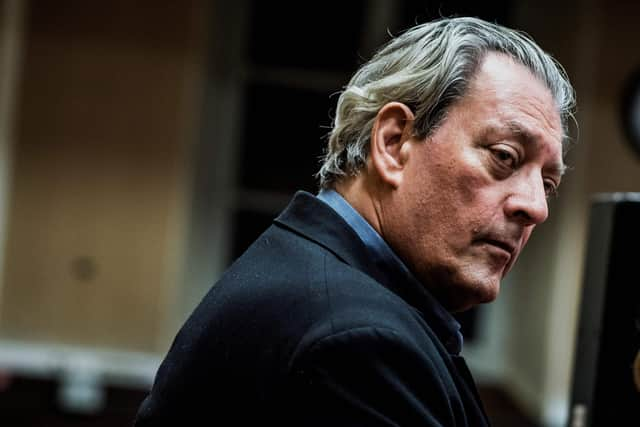Book review: Bloodbath Nation, by Paul Auster
I have sometimes wondered if Paul Auster is a writer who is more clever than compelling, more cerebral than empathetic. It can seem as if the typical Auster work is about The Novelist failing to write The Novel about a novelist writing a novel about two blind men playing chess in the night and communicating only using Makaton, while the Novelist does not realise his marriage is falling apart. I have enjoyed his work, particularly the early books up until, I suppose, The Book Of Illusions; but some of his later work seems self-plagiarising and self-indulgent (nowhere more so than the awful volume of correspondence with JM Coetzee, the only justification for which is that it is an elaborate hoax). The words of Elwood P Dowd, played by James Stewart in the magisterial Harvey, come back to me thinking about Auster: “Years ago my mother used to say to me, she'd say, "In this world, Elwood, you must be," – she always called me Elwood – "In this world, you must be oh so smart, or oh so pleasant." Well, for years I was smart. I recommend pleasant. You may quote me.”
In some ways, Bloodbath Nation is an attempt to short-circuit his own tricksiness and lack of affect. It is genuinely compelling, but remains problematic. It is clearly a book born out of conviction and passion, but the older Auster is always there. The “cold, dead hand”, to quote Charlton Heston when he was head of the National Rifle Association, still is gripping the pen if not the gun. It is, almost, a work of polemic but Auster resists this and works for an achingly perfected balance and nuance, which is nowhere in the current debate and therefore commendable in and of itself. For example, he writes, “the anti-gun-control minority is correct when that say gun violence is caused by the irresponsible or unhinged people who use guns” – and then the intelligent qualification – “but to say guns do not cause gun violence is no less ludicrous than saying that cars do not cause car crashes”. Is this, as he asks, “a question of pure mathematics?” No, it is a question about the why not the how of the situation. This slightly arch tone pervades the book. The “anti-gun-control minority” are “both right and wrong”. Quantum physics aside, it is either one or the other. When you read a sentence like “The problem is that many other people have fantasies about killing strangers or family members or friends or enemies and never do anything about it”, the queasiness about thinking of the gun epidemic as a problem around identifying and assessing and caring for individuals who need to get something out of their system, makes you realise, it’s the system.
Advertisement
Hide AdThe book is both a histology and a historiography of gun culture in the United States, taking in the Black Panthers alongside colonialism, the Second Amendment aside attempts to redefine a militia, Westerns and G-men. The five essays are interspersed with photographs by Spencer Ostrander, which are of scenes of mass-shootings. None, Auster notes, are “notable for the absence of human figures in them and the fact that no gun or even the suggestion of a gun is anywhere in sight”. They are “gravestones of our collective grief”. They are somewhat more than that. Looking at the motels and places of worship and schools and gas stations and cinemas is a mute testament. The aesthetic of the photographs is somewhere between the cinematography of David Lynch and Andrei Tarkovsky: dereliction, abandonment, the persistence of electrical wires, a feeling that teeters between horror and wistfulness.


By far the best part of this book is the fourth section. It opens in a typically Auster-ish way, with writing which is by him / not by him – his notes transcribing a friend, Frank Huyler, who is an emergency room doctor, detailing the nature of the different kinds of bullet wounds. It is close to Ginsberg’s Howl or Kaddish in its litany-like precision, and plays to Auster’s strengths of glacial clarity. It has, perhaps, the most significant line in the book: in terms of mass-killers he writes, “The single word that runs through all their stories is loneliness”. For a writer so singularly aloof – no-one does the God-like narrator like him – it is remarkably tender. I did find it strange, in an Auster-esque way, that serendipity, predestination, coincidence and fate collided in this essay, since in Bolano’s 2666 the fourth chapter is “The Part About The Crimes”, a meticulous and relentless “tolling of the dead”. It seems here to have a similar, quiet, un-flashy way of saying “this happened, and then this happened and then again this happened”.
In a moment almost unscripted, Auster writes “and just suppose for the sake of argument – to stretch the point to the utmost limit of absurdity – that I was appointed supreme ruler of the United States and then stood on a mountaintop and announced that my one and only act in office would be to buy back every gun in the country at five times its commercial value, in order to melt them down to make farm implements, my words would be construed as a declaration of war”. Then he blows it, by writing, “Before I reached the bottom of the mountain, I would have been killed a thousand times over”. I don’t like guns, and I dislike martyr-fantasies.
Bloodbath Nation, by Paul Auster, Faber & Faber, £25